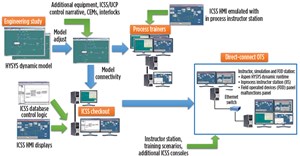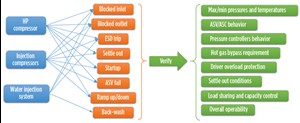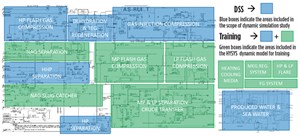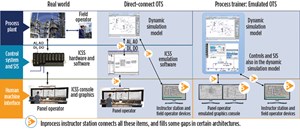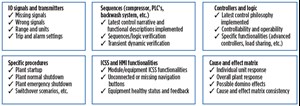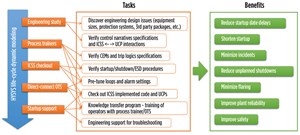FPSO lifecycle modeling adds benefits to development offshore West Africa
Yinson Production Pte Ltd (Yinson) recently converted a double-hull, very large crude carrier (VLCC) oil tanker to a Floating Production Storage and Offloading (FPSO) vessel for its development project offshore West Africa. In this project, the dynamic models from the engineering phase have been re-used for process design and control narrative validation; procedure verification; ICSS check-out; control room operator training; and support for FPSO start-up operations.
LIFECYCLE MODELING/FPSO PROJECT
The reason for a lifecycle approach comes from the advantage to exploit the potential synergies that appear, when the dynamic simulation analysis is carried on in a synchronized, integrated manner with the process engineering project. This approach provides decision information, reduces the uncertainty, and allows us to find answers to several questions at different stages of the project:
- Is the design suitable for all potential transients?
- Is the primary protection designed properly for the planned operational conditions?
- Will the safety system perform well?
- How will the vendor packages control system interface with the integrated control & safety system (ICSS)?
- Can we improve the plant’s availability?
- Is equipment protected?
- How to fully test the operating procedures?
- Code is massive in modern ICSS; can we test it in advance?
- How to effectively train experienced operators before the first oil?
- How to safely train inexperienced operators?
- How to train operators in the safety-critical process conditions?
BENEFIT OF LIFECYCLE MODELING
The benefit of using a lifecycle approach is that each phase addresses specific targets, which are aligned to the needs of the project. The process model is developed in successive refined steps, as more detailed information is available. These steps are listed below.
Phase 1: Process design and unit control validation. This focuses mainly on the overall design and control validation. Any early stage finding can be handled easily, to achieve the best solution with minimum modifications of the engineering design, and at minimum costs. This phase also increases plant safety significantly, as it targets the primary protection of the equipment to improve the trip settings, identify potential controllability issues, and shorten the start-up.
Phase 2: System integration and control narrative verification. Performing the integration of the different units in one model offers the possibility to test global scenarios that impact the overall process. This allows identification of potential interactions among process units and verification of the plant-wide process control strategy.
Phase 3: Procedure verification and process trainer. This offers the possibility to test all the operating procedures in advance, to increase the safety of the plant, improve the sequence duration, avoid undesired trips and reduce flaring occurrences. At this phase, the main safety logic is implemented (i.e. the critical trips settings are configured and enabled to be activated). Also, the basic inhibit and reset logic is defined. Additionally, performing an early training focused on the process at this stage has several advantages: 1) Operators can experience real plant events without causing disastrous results; 2) Knowledge is transferred for all the control interactions and critical points in advance; 3) Understanding is achieved from the transient dynamics and control response before the final ICSS database is released; and 4) Operators have more availability, as during first-oil operations their workload is more focused on field operations.
Phase 4: ICSS integration. Performing the ICSS checkout with the dynamic model allows a more robust, consistent check-out that reduces the commissioning time significantly, as well as controllability issues and false trip occurrences. This is the virtual commissioning phase of the DCS, and it normally requires several revision cycles of the ICSS database.
Phase 5: Operator training system. This phase exposes the operators to trip scenarios, specific operating procedures, disturbances and uncommon operations in a simulated environment, using the same ICSS and HMI that they use in the control room, providing the most realistic and efficient training. This phase improves the controllability and operability of the plant; increases the safety; minimizes incidents; reduces flaring; and speeds up planned start-ups and shutdowns.
Phase 6: OTS post-commissioning adjustments and FPSO start-up support. The direct-connect OTS solution validated in all the previous phases gains increased value, as it can be used for training purposes, start-up support operations, and performing future optimizations.
Project benefits. Following the different phases of the lifecycle modeling approach contributed to an early start up, of only two-and-a-half years after approval of the development plan, and three months ahead of schedule.
Yinson’s comments after the start-up include the following quotes:
- “The preparations through the simulator exercises and pre-tuning of the controllers really seems to pay off—basically, the operators have been running everything in auto since the start-up.”
- “We have been running through the oil train with diesel pumped by the diesel circulation pumps, down to the subsea flowlines and up into the oil separation train HP/MP/LP and to Offspec Tank. Looking really good. The variations in flow have been from 5 m³/hr to more than 230 m³/hr. All three vessels have a constant level and interface level.”
- “We have produced for about 40 hr in auto mode, with only some fine-tuning here and there. What can I say, except so far this model has performed far above all expectations. Very impressive.”
- “They actually managed to start the process in auto, and the oil process has been running smoothly for three days now, despite the wells being quite ‘sluggy’! This is quite extraordinary, and is something the company has never experienced before, according to feedback from start-up team.”
The oil and gas industry has already been reporting great benefits from OTS’s. In this regard, an electronic survey1 performed with 250 simulator users, estimates average savings generated by simulator training in the Norwegian oil and gas industry of $15.3 million.
YINSON’S LIFECYCLE MODELING APPROACH
The Lifecycle modeling approach was introduced with Aspen HYSYS during the 1990s. The “one model, many uses” concept is sometimes misinterpreted, creating unrealistic expectations. But on the other hand, models are often created with a specific purpose in mind, and other potential applications are left unexploited.
The aim of this approach (Fig. 1) is to re-use the detailed models from the engineering phase for process design and control narrative validation, procedure verification, ICSS check-out, control room operator training, and support for FPSO start-up operations.
Nevertheless, completion of these phases requires the usage of a dynamic model based on first principles, which allows the following:
- Model consistency: Thermodynamic packages consistent with steady-state design models. Data are introduced once, and the model is used along the phases of the
lifecycle. - Growing detail/scope: Detailed equipment data are available and refined as the project evolves. Additional process units can be incorporated, as needed, in the application.
- Rigor: A model based on thermodynamic and physical property packages provides a realistic process response, which is the key to validate the control logic, improve the procedures, tune the controllers, provide realistic operator training sessions and define the trip and alarm settings.
- Extrapolation: Extrapolate process conditions far from nominal. The model will help to determine the settings to maximize production, reduce flaring, improve the control, and evaluate the plant’s performance under non-design conditions.
- Reusability: The dynamic model can be re-used with minor modifications for other specific purposes (i.e. optimizations, debottlenecking studies, etc.).
- Maintainability: Model update workflow is defined to keep the model alive and synchronized with the modifications performed in the process, control and procedure.
SELECTING WHO PERFORMS THE LIFECYCLE APPROACH
After understanding the added value of performing a lifecycle approach with a first-principle model, Yinson decided to fully exploit its lifecycle modeling approach by outsourcing the development of its OTS to a supplier (Inprocess), which is independent from the ICSS vendor, for several reasons:2
Fast-tracking projects: By building an early OTS based on dynamic models, you are freed up from waiting until every detail and revision of the ICSS is complete.
Safer operations: By basing the OTS on engineering dynamic process models, more rigorous and comprehensive safety scenarios can be considered, and impacts can be modeled and assessed.
Operator training as an area of excellence: By entrusting the development of the OTS to dynamic modeling experts, you are involving teams that are passionate about the topic. You are selecting for excellence rather than just tacking a must-have to a contractor focused elsewhere.
Optimizing for cost and responsiveness: By decoupling the OTS from the ICSS vendor, the owner is encouraging competition, and more likely to get the most responsive and best price/performance solution.
Agility: A dynamic modeling team, not dependent on the ICSS design and delivery, can be very responsive to changes in operating objectives, staffing plans, regulations, etc.
LIFECYCLE PHASES
The lifecycle approach is executed in phases, and the model is developed in a modular manner, following successive refining steps. The advantage of this approach is that it does not require all the process information to be ready at the same time, but allows starting the unit analysis when the information is available.
Phase 1: Process design and unit control validation. Oil and gas processes have shown substantial effort to improve the plant’s efficiency and profitability, while operating at the highest quality standards and complying stringently with international and national regulations.
New technologies and more complex control strategies are required that increase the uncertainty and risk of the operations. Therefore, this phase addresses the necessity to test the design and control strategies in advance, to ensure that everything will work as intended. In case any modification is required, there is sufficient time to perform the changes at minimal cost.
Consequently, 20 dynamic simulation studies (Fig. 2) were performed in the units where significant interactions or complex procedures were foreseen (i.e. compression and water injection system), with the objective of ensuring the process safety, and the plant’s controllability and operability.
After analyzing the plant’s transient dynamics, the control logic response and the procedures, the following findings were obtained:
- Necessity of a discharge pressure override controller for throttle valve
- Settings of the anti-surge controller to avoid trip conditions
- Requirement of additional protective equipment in surge scenarios
- Settle-out conditions after emergency shutdown (ESD)
- No power constraint identified during the compressor start-up at the worst initial conditions (highest settle-out pressure and molecular weight)
- Verification of alarms, trip limits and PSV settings
- Insight into the process response and interlocks during the execution of specific procedures were gained
- Verification of 3rd-party package procedures.
Phase 2: System integration/control narrative verification. After analyzing the most complex units, and the required modifications were implemented, the next step was to increase the model scope (Fig. 3), integrate existing unit stand-alone models and develop the additional process areas not considered in the previous phase, implement the latest control logic, and update the Unit Control Panel (UCP) sequences—i.e. start-up, ESD, Process Shutdown (PSD), normal shutdown, full recycle mode, etc.—from the compressor packages.
Afterwards, the dynamic model was used to:
- Analyze the control interactions between the PCS and the UCP.
- Verify the controllability and operability during normal operating conditions, non-design conditions, and the execution of specific procedures.
- Identify possible limitations of the equipment or control system.
- Pre-set controllers, alarms and trip limits.
- Validate the efficiency of the protective equipment during all scenarios.
Afterwards, a report was delivered, which highlighted:
- Control interactions
- Inconsistencies between the different SP’s and selectors under the various operating modes
- Consistency between the sensor range, and the trip and alarm settings
- Failed or inefficient control strategies.
Phase 3A: Procedure verification. Validating and optimizing the operating procedures is another important task, as it maintains the equipment protected, improves the plant’s performance, minimizes incidents, improves the sequence duration and minimizes flaring occurrences.
In this regard, an inside-out approach was used to initially evaluate the transient behavior of each individual unit, to later evaluate its impact in the overall start-up or normal shutdown process.
Additionally, it should be noted that a realistic control response is only achieved by combining the know-how from experienced CRO’s and experienced process modeling engineers. Therefore, the main process operational procedures were drafted and validated in a close interaction between Yinson and Inprocess.
Phase 3B: Early CRO’s training. More often than desired, the final release of the ICSS is available, close to, or beyond, the deadlines preliminarily established. As a consequence, traditional direct-connect OTS solutions, using the same soft controllers as in the operator control room, are sometimes only available after the plant has already been started, leaving no space for preliminary simulator training.
To solve this fact, and taking into account that in our case, the models were already available from the engineering studies, an early process trainer was developed, Fig. 4. This involved the implementation of the control and safety systems in the process simulation software.
The proposed training sessions needed to cover real plant events and be valid to transfer all the accumulated knowledge that was gained along the previous project phases. Therefore, the training scenarios included the following topics:
- Specific procedures: Execution of several procedures already validated by senior operators, such as plant start-up, plant normal shutdown, switch-over scenarios, etc.
- Trip scenarios: Unit or equipment emergency shutdown scenarios and their implications.
- Disturbances and malfunctions: Online disturbances introduced (i.e. system backpressure, trips, flow from wells, etc.) to test the operators’ capability to stabilize the system and avoid trip conditions.
A preliminary pre-FAT version of the ICSS database was available during this stage, so the training sessions also included the familiarization of the ICSS screens and its main functions.
Phase 4: ICSS integration (ICSS database checkout). Modern ICSS databases contain massive code lines to keep the system protected and in control. Nevertheless, this process requires exhaustive verification to ensure that all the IO signals have been properly connected, and the ICSS has been programmed in accordance to the latest information.
Therefore, the approach followed during this stage was to emulate the plant with the dynamic model and send all the necessary IO signals to the ICSS emulator to evaluate its performance and allow a more robust and consistent checkout.
Traditionally, the ICSS Factory Acceptance Test (FAT) is performed by verifying, loop by loop, the IO signals and logic while validating the ICSS with a process emulation model stimulates the control system with realistic process signals and control interactions. This allows an exhaustive testing and verification (Fig. 5) of the ICSS performance and outcomes.
The testing and verification activities performed during this phase imply virtual commissioning of the ICSS, and consequently gives a guarantee that the implementation and setting of the control system is in accordance with the expected process response.
Phase 5: Direct-connect operator training system. The main objectives of an operator training system are to train operators, improve their performance, promote safer operations, and increase the profitability of the plant by executing different sets of scenarios (i.e. specific procedures, upset scenarios, disturbances, etc.) in a simulation environment.
A direct-connect OTS approach was used in this phase, which consisted of the connection of the same ICSS software and HMI used in the FPSO, with the plant simulated using Aspen HYSYS dynamics. Additionally, all the field operator devices (i.e. manual valves, switches, local instruments) and local control panels necessary to perform specific procedures or scenarios were included to deliver a complete OTS solution.
To make this possible, the Inprocess Instructor Station (IIS) software was used to manage all the communication data nodes, create additional screens for the field operator devices and use advanced OTS functionalities (e.g. load models, save snapshots, insert malfunctions, load scenarios, log actions, evaluate operator´s performance, etc.).
The advantage of this solution is that the operators are trained following a realistic approach, where they use the same software encountered in the operator control room and the transient behavior of the plant is highly reliable, as it is based on a first-principle model. Moreover, the scenarios tackle uncommon but possible situations that require the operator’s awareness and actions to maintain the plant, stable and protected.
Phase 6: FPSO start-up support. Reusing the dynamic models from the engineering phase, and connecting the models to the ICSS software, provides increased added value to the project itself, as it is not only used for training purposes but it becomes a valuable tool to address uncertainties and perform future optimizations.
First-oil operations bring increased uncertainty and operational challenges, which typically require:
- Operating in uncommon configurations
- Operating in non-design conditions
- Controller tuning
- Deep understanding of the control logic and transient dynamics.
Consequently, the direct-connect OTS solution was used initially to support the FPSO start-up operations by tuning the controllers (i.e. initially at default values) to provide a smooth transient response and increase the overall stability of the plant.
Afterwards, the plant simulated in the OTS was fully stopped by the normal shutdown procedure, then the wells were predefined to their expected initial conditions (e.g. flowrates, oil-gas ratio, water cut, etc.), and the start-up procedure was executed to verify the controllability and operability of the plant while minimizing flaring occurrences.
OPERATOR COMPETENCY TRAINING
Yinson, in adherence to its Asset Integrity Management, needed an operator competency development plan, based on a high-fidelity simulator model that should involve the pre-operation, operation and continuous improvement phases of the FPSO:
- The program begins with training sessions to get familiarized with the system, and to identify and understand its limitations. The Process Trainer is used to gain process insight, and to verify and improve the operating procedures.
- Once the process model is connected to the emulated ICSS, training
sessions for all scenarios will commence with the Direct-Connect OTS solution. - Finally, the need for refreshment and continuous improvement (tuning and debottlenecking) during the operations phase leads to continuous updates of the real ICSS and the OTS.
CONCLUSION
A new lifecycle modeling approach has been proposed, which re-uses the dynamic models from the engineering phase for process design and control narrative validation, procedure verification, ICSS check-out, control room operator training and support for FPSO start-
up operations.
The phases are aligned with the specific needs of the project, to provide the necessary information to the engineering team and solve any issue encountered, which assists the project’s success, Fig. 6.
The project outcome provides a good indication of the success of the approach, as production operations started three months ahead of scheduling and only two-and-a-half years after approval of the development plan. Additionally, Yinson’s comments highlight the criticality of the simulator exercises and controller pre-tuning, to achieve smooth transitions during the start-up operations. ![]()
References
1. Komulainen T. M., H. Nordhus, B. Nordstein and R. Sannerud, “Economic benefits of training simulators,” World Oil, December 2012, pp. 61–65.
2. Beck, R., “A dynamic model: The essential accompanist to the project conductor!. [homepage on the Internet]. Massachusetts: Aspen Technology; 2017 [updated June 14, 2016; cited Aug. 1, 2017]. Available from: http://www.aspentech.com/epcperspectives/Topics/Design-Optimization/A-Dynamic-Model--The-Essential-Accompanyist-to-the-Project-Conductor!/.
- Advancing offshore decarbonization through electrification of FPSOs (March 2024)
- What's new in production (February 2024)
- Subsea technology- Corrosion monitoring: From failure to success (February 2024)
- U.S. operators reduce activity as crude prices plunge (February 2024)
- U.S. producing gas wells increase despite low prices (February 2024)
- U.S. oil and natural gas production hits record highs (February 2024)

